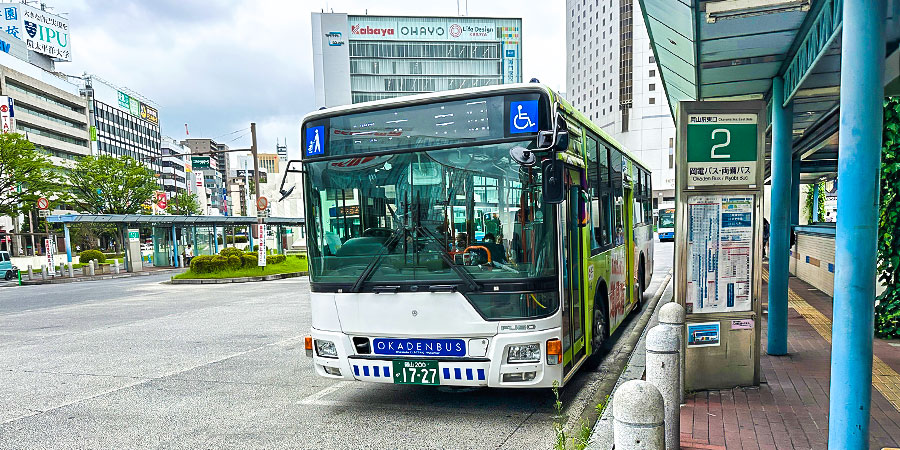City Bus/Public Bus in Japan
The humanized city buses in Japan are equipped with comfortable soft seats and adequate handrails or something to hold on to, while wheelchair seating is available for disabled people on some city buses.

City Bus in Okayama, Japan
|
How to Take & Buy the Ticket
 Boarding a City Bus
Boarding a City Bus
When the bus gets to the bus stop, you should notice the reminder on the doors, so as to distinguish the door to get on from the other to get off. You may also follow the local boarding crowd to find the right door to get on a bus.
 Paying First: The Fixed Fare
Paying First: The Fixed Fare
Some public buses request a fixed fare, no matter how many stops you travelled. Thus, you can drop cashes/coins or swipe your transportation card when getting on. Make sure that your transportation card can be used on the bus.
 Payment just before Getting Off: Distance-Measured Fare
Payment just before Getting Off: Distance-Measured Fare
The ticket fare of some city buses is metered by the distance, so you should pay for the ticket when getting off. When boarding the bus, you should swipe your transportation card, and swipe the same card again for a successful payment when getting off.With no transportation card, you need take out a boarding voucher from the box labeled. The big number on the boarding voucher represents the stop you get on. To the stop to get off, you can match your number on the voucher to that on the electronic display, which shows the exact fare you should pay. Then, you can put your change together with your boarding voucher into the fare box. On some buses, you may need to show the driver the number on your boarding voucher before dropping your change.
 Pushing the Button to Get Off
Pushing the Button to Get Off
There is a button “I want to get off” on each seat or the vertical handrails on the city bus in Japan. As your destination stop comes, you need to push the button to tell the driver that you want to get off.
|
|
|
Tips for Taking a City Bus in Japan
• You must queue up for getting on/off the public buses, no matter what is the weather like. Don’t worry, the driver would restart the bus till all the passengers have gotten on or off.• Please do not get up or move from your seat until the bus stops.
• No smoking on any public bus, and no phone call.
• Please prepare your transportation card or the change ready when boarding. The basic fare or the staring fare of a city bus is about JPY 200 in Japan. Some buses are provided with a small machine to make change.
Transportation Cards
A transportation IC card is useful and convenient to take the buses, ferries and some trains operated by the issuing company, and even go shopping in convenience stores in Japan. Some transportation cards can only be utilized in the region it issued, and some have been valid nationwide. The most-used transportation cards include Suica, PASMO, ICOCA, and Manaca.Suica card by JR East is the most popular in Japan, and is applicable in the Kanto area centered on Tokyo and railways to Sendai, Niigata, Hokkaido and more regions. It’s the most used, as Welcome Suica for oversea tourists and online card with mobile payment are launched. You can purchase a Welcome Suica when arriving at Haneda Airport with no guarantee deposit, or get the online card via your Apple Pay.

One-Day Bus Pass, Nara
|
Bus Pass
Bus pass is also available in some cities of Japan. If you will have public bus trips frequently in a few days in the city, a bus pass is definitely helpful to save money, as you can take the buses unlimitedly during the valid period. Kyoto one-day pass, Toei Bus one-day pass in Tokyo, Sendai one-day city bus pass, and so on are all hot-selling.For example, when you take a bus with your bus pass in Kyoto, insert the pass to insertion port. After pulled out, the bus pass would be stamped with the date of that day. Then, you only need to show the bus pass with the date to the driver when you take the bus.
Read More: How to Travel around Japan: What’s the Best Way

